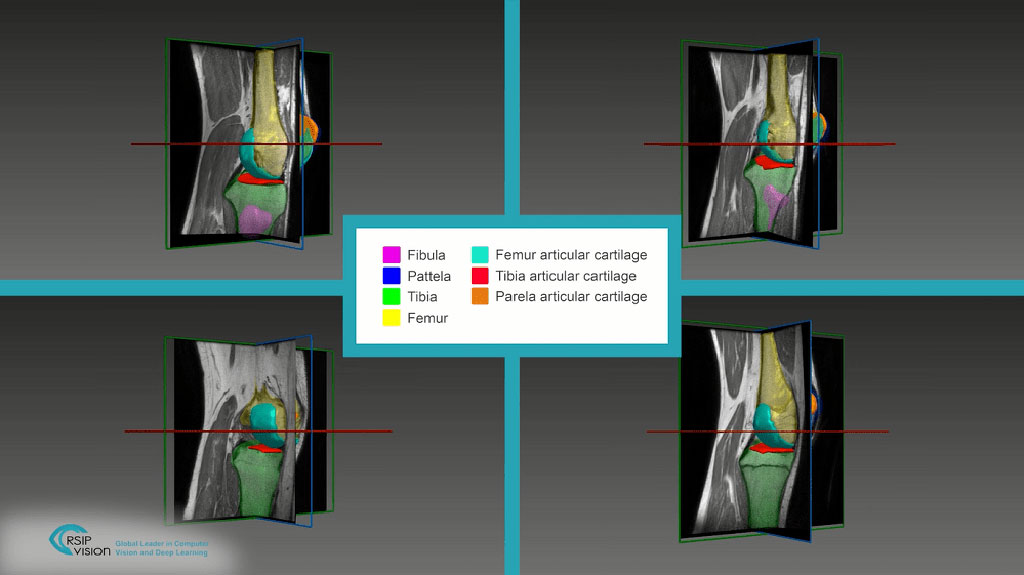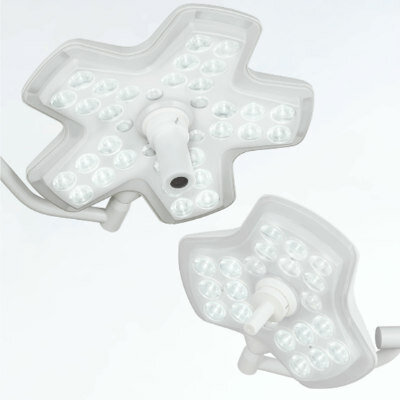AI Tool Improves Diagnosis of Joint Cartilage Defects
|
By HospiMedica International staff writers Posted on 03 Aug 2021 |

A novel AI tool aids articular cartilage segmentation (Photo courtesy of RSIP Vision)
New artificial intelligence (AI) software provides fully automated precise segmentation and robust assessment of chondral lesions, including location, diameter, shape, and boundaries.
The RSIP Vision (Jerusalem, Israel) articular cartilage segmentation tool is an AI algorithm designed to deliver accurate, non-invasive and automatic assessment of chondral lesions in magnetic resonance imaging (MRI) scans of the hips, knees, and ankles. The algorithm provides an accurate measurement of the location, geometry, and boundaries of osteochondral lesions, enabling physicians to evaluate the extent of the damage, select the appropriate treatment approach, and assess its efficacy.
The segmentation is carried out by classifying image pixels (or voxels, in 3D cases) using random forest classifiers, which delineate the boundaries between points in feature space belonging to different classes. The random forest is composed of an ensemble of decision trees, trained to assign membership value to either the lesion or the background group. To construct each tree, a different bootstrap subset of the training data is chosen at random. Since trees are uncorrelated, the overall decision in random forest is consistent by using a majority vote of trees with different structure.
“Our new segmentation tool makes it easier to pinpoint specific points and boundaries in images, which in turn leads to greater accuracy during surgeries without being dependent on the capability and experience of a specific individual,” said Ron Soferman, founder & CEO of RSIP Vision. “RSIP Vision will continue to drive innovation in image analysis across the medical verticals through custom software, advanced algorithm development and custom technologies.”
“Analyzing the parameters of the lesion and its boundaries allows the surgeon, along with the patient, to choose the ideal cartilage repair technique,” said orthopedic surgeon Shai Factor, MD, of Tel Aviv Sourasky Medical Center (Israel). “Additionally, in cases where cartilage transfer is the chosen option, this technology will make it possible to map the donor cartilage area as well and plan the surgery in the best way that will lead to better outcomes.”
Chondral lesions are prevalent among young and active patients, and due to the avascular nature of articular cartilage, healing potential is limited. In many cases, chondral lesions limit the athlete’s ability to participate in sports and even affect their daily activities. Cartilage segmentation is a crucial tool that aids the physician in choosing optimal treatment for the patient, including mosaicplasty, micro-fracture, osteochondral autograft transfer system (OATS), or autologous chondrocyte implantation.
Related Links:
RSIP Vision
The RSIP Vision (Jerusalem, Israel) articular cartilage segmentation tool is an AI algorithm designed to deliver accurate, non-invasive and automatic assessment of chondral lesions in magnetic resonance imaging (MRI) scans of the hips, knees, and ankles. The algorithm provides an accurate measurement of the location, geometry, and boundaries of osteochondral lesions, enabling physicians to evaluate the extent of the damage, select the appropriate treatment approach, and assess its efficacy.
The segmentation is carried out by classifying image pixels (or voxels, in 3D cases) using random forest classifiers, which delineate the boundaries between points in feature space belonging to different classes. The random forest is composed of an ensemble of decision trees, trained to assign membership value to either the lesion or the background group. To construct each tree, a different bootstrap subset of the training data is chosen at random. Since trees are uncorrelated, the overall decision in random forest is consistent by using a majority vote of trees with different structure.
“Our new segmentation tool makes it easier to pinpoint specific points and boundaries in images, which in turn leads to greater accuracy during surgeries without being dependent on the capability and experience of a specific individual,” said Ron Soferman, founder & CEO of RSIP Vision. “RSIP Vision will continue to drive innovation in image analysis across the medical verticals through custom software, advanced algorithm development and custom technologies.”
“Analyzing the parameters of the lesion and its boundaries allows the surgeon, along with the patient, to choose the ideal cartilage repair technique,” said orthopedic surgeon Shai Factor, MD, of Tel Aviv Sourasky Medical Center (Israel). “Additionally, in cases where cartilage transfer is the chosen option, this technology will make it possible to map the donor cartilage area as well and plan the surgery in the best way that will lead to better outcomes.”
Chondral lesions are prevalent among young and active patients, and due to the avascular nature of articular cartilage, healing potential is limited. In many cases, chondral lesions limit the athlete’s ability to participate in sports and even affect their daily activities. Cartilage segmentation is a crucial tool that aids the physician in choosing optimal treatment for the patient, including mosaicplasty, micro-fracture, osteochondral autograft transfer system (OATS), or autologous chondrocyte implantation.
Related Links:
RSIP Vision
Channels
Critical Care
view channel
CPR Guidelines Updated for Pediatric and Neonatal Emergency Care and Resuscitation
Cardiac arrest in infants and children remains a leading cause of pediatric emergencies, with more than 7,000 out-of-hospital and 20,000 in-hospital cardiac arrests occurring annually in the United States.... Read more
Ingestible Capsule Monitors Intestinal Inflammation
Acute mesenteric ischemia—a life-threatening condition caused by blocked blood flow to the intestines—remains difficult to diagnose early because its symptoms often mimic common digestive problems.... Read more
Wireless Implantable Sensor Enables Continuous Endoleak Monitoring
Endovascular aneurysm repair (EVAR) is a life-saving, minimally invasive treatment for abdominal aortic aneurysms—balloon-like bulges in the aorta that can rupture with fatal consequences.... Read more
Wearable Patch for Early Skin Cancer Detection to Reduce Unnecessary Biopsies
Skin cancer remains one of the most dangerous and common cancers worldwide, with early detection crucial for improving survival rates. Traditional diagnostic methods—visual inspections, imaging, and biopsies—can... Read moreSurgical Techniques
view channel
Robotic Assistant Delivers Ultra-Precision Injections with Rapid Setup Times
Age-related macular degeneration (AMD) is a leading cause of blindness worldwide, affecting nearly 200 million people, a figure expected to rise to 280 million by 2040. Current treatment involves doctors... Read more
Minimally Invasive Endoscopic Surgery Improves Severe Stroke Outcomes
Intracerebral hemorrhage, a type of stroke caused by bleeding deep within the brain, remains one of the most challenging neurological emergencies to treat. Accounting for about 15% of all strokes, it carries... Read morePatient Care
view channel
Revolutionary Automatic IV-Line Flushing Device to Enhance Infusion Care
More than 80% of in-hospital patients receive intravenous (IV) therapy. Every dose of IV medicine delivered in a small volume (<250 mL) infusion bag should be followed by subsequent flushing to ensure... Read more
VR Training Tool Combats Contamination of Portable Medical Equipment
Healthcare-associated infections (HAIs) impact one in every 31 patients, cause nearly 100,000 deaths each year, and cost USD 28.4 billion in direct medical expenses. Notably, up to 75% of these infections... Read more
Portable Biosensor Platform to Reduce Hospital-Acquired Infections
Approximately 4 million patients in the European Union acquire healthcare-associated infections (HAIs) or nosocomial infections each year, with around 37,000 deaths directly resulting from these infections,... Read moreFirst-Of-Its-Kind Portable Germicidal Light Technology Disinfects High-Touch Clinical Surfaces in Seconds
Reducing healthcare-acquired infections (HAIs) remains a pressing issue within global healthcare systems. In the United States alone, 1.7 million patients contract HAIs annually, leading to approximately... Read moreHealth IT
view channel
Printable Molecule-Selective Nanoparticles Enable Mass Production of Wearable Biosensors
The future of medicine is likely to focus on the personalization of healthcare—understanding exactly what an individual requires and delivering the appropriate combination of nutrients, metabolites, and... Read moreBusiness
view channel
Philips and Masimo Partner to Advance Patient Monitoring Measurement Technologies
Royal Philips (Amsterdam, Netherlands) and Masimo (Irvine, California, USA) have renewed their multi-year strategic collaboration, combining Philips’ expertise in patient monitoring with Masimo’s noninvasive... Read more
B. Braun Acquires Digital Microsurgery Company True Digital Surgery
The high-end microsurgery market in neurosurgery, spine, and ENT is undergoing a significant transformation. Traditional analog microscopes are giving way to digital exoscopes, which provide improved visualization,... Read more
CMEF 2025 to Promote Holistic and High-Quality Development of Medical and Health Industry
The 92nd China International Medical Equipment Fair (CMEF 2025) Autumn Exhibition is scheduled to be held from September 26 to 29 at the China Import and Export Fair Complex (Canton Fair Complex) in Guangzhou.... Read more














